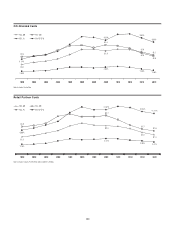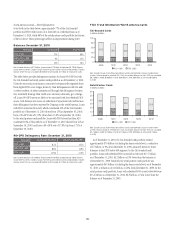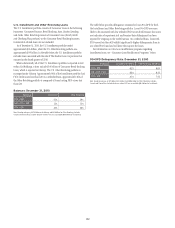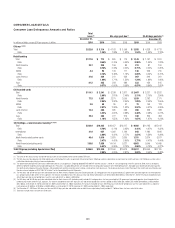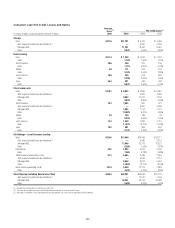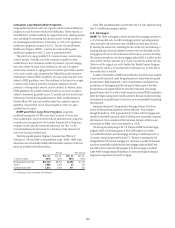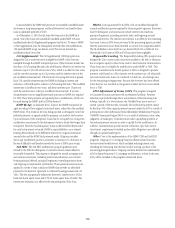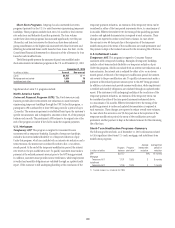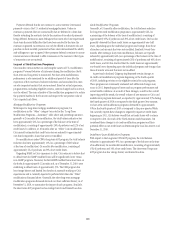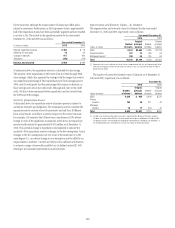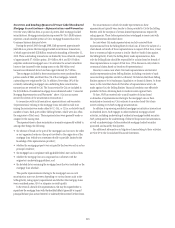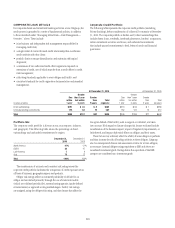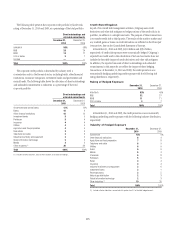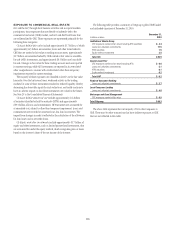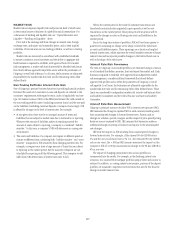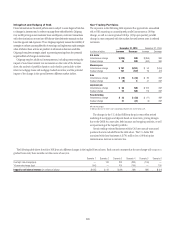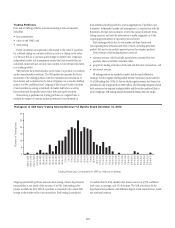Citibank 2010 Annual Report Download - page 111
Download and view the complete annual report
Please find page 111 of the 2010 Citibank annual report below. You can navigate through the pages in the report by either clicking on the pages listed below, or by using the keyword search tool below to find specific information within the annual report.109
Payment deferrals that do not continue to accrue interest (extensions)
primarily occur in the U.S. residential mortgage business. Under an
extension, payments that are contractually due are deferred to a later date,
thereby extending the maturity date by the number of months of payments
being deferred. Extensions assist delinquent borrowers who have experienced
short-term financial difficulties that have been resolved by the time the
extension is granted. An extension can only be offered to borrowers who are
past due on their monthly payments but have since demonstrated the ability
and willingness to pay as agreed. Other payment deferrals continue to accrue
interest and are not deemed to offer concessions to the customer. Other types
of concessions are not material.
Impact of Modification Programs
Citi considers various metrics in analyzing the success of U.S. modification
programs. Payment behavior of customers during the modification (both
short-term and long-term) is monitored. For short-term modifications,
performance is also measured for an additional period of time after the
expiration of the concession. Balance reductions and annualized loss rates
are also important metrics that are monitored. Based on actual experience,
program terms, including eligibility criteria, interest charged and loan tenor,
may be refined. The main objective of the modification programs is to reduce
the payment burden for the borrower and improve the net present value of
Citi’s expected cash flows.
Mortgage Modification Programs
With respect to long-term mortgage modification programs, for
modifications in the “Other” category (as noted in the “Long-Term
Modification Programs—Summary” table above and preceding narrative),
generally at 24 months after modification, the total balance reduction has
been approximately 32% (as a percentage of the balance at the time of
modification), consisting of approximately 20% of paydowns and 12% of net
credit losses. In addition, at 18 months after an “Other” loan modification,
Citi currently estimates that credit loss rates are reduced by approximately
one-third compared to loans that were not modified.
For modifications under CFNA’s long-term AOT program, the total balance
reduction has been approximately 13% (as a percentage of the balance
at the time of modification) 24 months after modification, consisting of
approximately 4% of paydowns and 9% of net credit losses.
Regarding HAMP, in Citi’s experience to date, Citi continues to believe that
re-default rates for HAMP modified loans will be significantly lower versus
non-HAMP programs. Moreover, the first HAMP modified loans have been on
the books for approximately 12 months and, as of December 31, 2010, were
exhibiting re-default rates of approximately 15%. The CSM program has
less vintage history and limited loss data but is currently tracking to Citi’s
expectations and is currently expected to perform better than the “Other”
modifications discussed above. Generally, the other long-term mortgage
modification programs discussed above do not have sufficient history, as of
December 31, 2010, to summarize the impact of such programs. Similarly,
the short-term AOT program has less vintage history and limited loss data.
Cards Modification Programs
Generally, at 24 months after modification, the total balance reduction
for long-term card modification programs is approximately 64% (as
a percentage of the balance at the time of modification), consisting of
approximately 35% of paydowns and 29% of net credit losses. Citi has also
generally observed that these credit losses are approximately one-half
lower, depending upon the individual program and vintage, than those
of similar card accounts that were not modified. Similarly, twenty-four
months after starting a short-term modification, balances are typically
reduced by approximately 64% (as a percentage of the balance at the time of
modification), consisting of approximately 24% of paydowns and 40% of net
credit losses, and Citi has observed that the credit losses are approximately
one-fourth lower, depending upon the individual program and vintage, than
those of similar accounts that were not modified.
As previously disclosed, Citigroup implemented certain changes to
its credit card modification programs beginning in the fourth quarter
of 2010, including revisions to the eligibility criteria for such programs.
These programs are continually evaluated and additional changes may
occur in 2011, depending upon factors such as program performance and
overall credit conditions. As a result of these changes, as well as the overall
improving portfolio trends, the overall volume of new entrants to Citi’s card
modification programs decreased, as expected, by approximately 25% during
the fourth quarter of 2010 as compared to the third quarter. New entrants
to short-term card modification programs decreased by approximately
50% in the fourth quarter of 2010 as compared to the prior quarter. While
Citi currently expects these changes to negatively impact net credit losses
beginning in 2011, Citi believes overall that net credit losses will continue
to improve in 2011 for each of the North America cards businesses. Citi
considered these changes to its cards modification programs and their
potential effect on net credit losses in determining the loan loss reserve as of
December 31, 2010.
Installment Loan Modification Programs
With respect to the long-term CFNA AOT program, the total balance
reduction is approximately 49% (as a percentage of the balance at the time
of modification) 24 months after modification, consisting of approximately
13% of paydowns and 36% of net credit losses. The short-term Temporary
AOT program has less vintage history and limited loss data.



